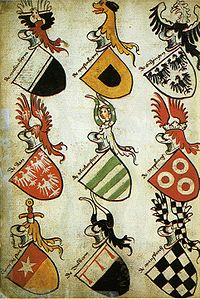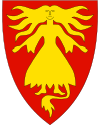Welcome to the Heraldry and Vexillology Portal!


Vexillology (from the Latin vexillum, a flag or banner) is the scholarly study of flags, including the creation and development of a body of knowledge about flags of all types, their forms and functions, and of scientific theories and principles based on that knowledge. Flags were originally used to assist military coordination on the battlefield, and have evolved into a general tool for signalling and identification, particularly identification of countries.
Heraldry encompasses all of the duties of a herald, including the science and art of designing, displaying, describing and recording coats of arms and badges, as well as the formal ceremonies and laws that regulate the use and inheritance of arms. The origins of heraldry lie in the medieval need to distinguish participants in battles or jousts, whose faces were hidden by steel helmets.
Selected article
Ireland King of Arms was the title of an Irish officer of arms from 1392 until the accession of Henry VII as King of England in 1485. The office was replaced in 1552 by that of Ulster King of Arms, which in 1943 was merged with Norroy King of Arms forming the present office of Norroy and Ulster King of Arms. In theory, Ireland King of Arms enjoyed heraldic jurisdiction in the whole of the Lordship of Ireland. (more...)
Selected flag

The term flag of convenience describes the business practice of registering a merchant ship in a sovereign state different from that of the ship's owners. The term refers to the civil ensign the ship flies to indicate its country of registration or flag state. A ship operates under the laws of its flag state, and these laws are used if the ship is involved in an admiralty case. The modern practice of flagging ships in foreign countries began in the 1920s in the United States, when shipowners frustrated by increased regulations and rising labor costs began to register their ships to Panama. As of 2009, more than half of the world’s merchant ships are registered under flags of convenience. (more...)
Selected biography

William Camden (May 2, 1551–November 9, 1623) was an English antiquarian and historian. He wrote Britannia, the first topographical survey of the island of Great Britain, and Annales, the first detailed historical account of the reign of Elizabeth I of England. In 1597 he was appointed Clarenceux King of Arms to facilitate his research, the post carrying a salary, and the College of Arms at the time being a centre of antiquarian studies. The appointment, however, roused the jealousy of the herald Ralph Brooke, who in retaliation published an attack on Britannia, charging Camden with inaccuracy and plagiarism. Camden successfully defended himself against the charges in subsequent editions of the work. (more...)
Selected picture

The Hyghalmen Roll was made in the late fifteenth century and illustrates the German practice of repeating themes from the arms in the crest.
Did you know...
- ...that the Coat of arms of Lardal (pictured) in Norway features a hulder as a charge?
- ...that the seals of the graduate schools of Harvard University were designed by Pierre de Chaignon la Rose?
- ...that the coat of arms of Ullensaker is the only Norwegian municipal coat of arms depicting a Norse god?
- ...that the Samara flag, presented as a gift from Russia to the Bulgarian volunteers in the Russo-Turkish War of 1877–78, is the only flag awarded a Bulgarian Medal for Bravery?
- ...that educator Anna Essinger, ordered to fly the swastika on Hitler's birthday in 1933, planned a day-long outing for her school, leaving the flag to fly over an empty building?
Related portals
Major topics and navigation
|
|
|
Heraldry Web resources
Authorities
- Belgium - The Council of Nobility, Flemish Heraldic Council and Council of Heraldry and Vexillology of the French Community
- Canada - Canadian Heraldic Authority and see also Public Register of Arms, Flags and Badges
- England, Wales, and Northern Ireland - The College of Arms
- Ireland - The Office of the Chief Herald of Ireland
- Netherlands - High Council of Nobility
- Portugal - Instituto da Nobreza Portuguesa
- Scotland - The Court of the Lord Lyon
- South Africa - South African Bureau of Heraldry
- Sweden - National Board of Heraldry, The National Archive
- United States Army - The United States Army Institute of Heraldry
Societies
- Greek Heraldry Society
- The Academy of Heraldic Science Czech republic
- The American College of Heraldry
- The American Heraldry Society
- The Augustan Society
- The Australian Heraldry Society Inc.
- Bulgarian Heraldry and Vexillology Society
- The Center for Research of Orthodox Monarchism
- Cambridge University Heraldic and Genealogical Society
- Chiltern Heraldry Group
- The College of Dracology
- Croatian Heraldic and Vexillologic Association
- The Finnish Heraldic Society
- Fryske Rie foar Heraldyk
- Hellenic Armigers Society
- Guild of Heraldic Artists
- Genealogical Society of Ireland
- Heraldry Research Institute (Japan)
- The Heraldry Society
- The Heraldry Society of Africa
- The Heraldry Society of New Zealand Inc.
- The Heraldry Society of Scotland
- The Heraldry Society of Southern Africa
- The Institute of Heraldic and Genealogical Studies
- The International Association of Amateur Heralds
- Italian Center of Vexillological Studies
- Lancashire Heraldry Group
- Macedonian Heraldry Society
- New England Historic Genealogical Society Committee on Heraldry
- Norwegian Heraldry Society
- Oxford University Heraldry Society
- Polish Heraldry Society
- Polish Nobility Confederation
- Real Academia Matritense de Heráldica y Genealogía - Royal Academy of Heraldry and Genealogy of Madrid
- Romanian Institute for Genealogy and Heraldry
- The Royal Heraldry Society of Canada
- The Russian College of HeraldryThe Russian College of Heraldry
- Serbian Heraldic Society
- Societas Heraldica Scandinavica
- Societas Heraldica Slovenica
- Swedish Heraldic Society
- Ukrainian Heraldry Society
- Royal Association Genealogical and Heraldic Office of Belgium
Vexillology
Software
- Coat of Arms Visual Designer web-based program
- Puncher Heraldry Program
- Blazonry Server - pyBlazon
- DrawShield - creates SVG shield or arms image from blazon
- CoaMaker - web-based tool
- Blazon95 and BLAZONS! 2000, older Windows applications
- Heraldicon
Texts
- Heraldry, historical and popular : with seven hundred illustrations (1863)
- A Complete Guide to Heraldry (1909)
Other
Wikimedia
The following Wikimedia Foundation sister projects provide more on this subject:
-
Commons
Free media repository -
Wikibooks
Free textbooks and manuals -
Wikidata
Free knowledge base -
Wikinews
Free-content news -
Wikiquote
Collection of quotations -
Wikisource
Free-content library -
Wikispecies
Directory of species -
Wikiversity
Free learning tools -
Wikivoyage
Free travel guide -
Wiktionary
Dictionary and thesaurus











